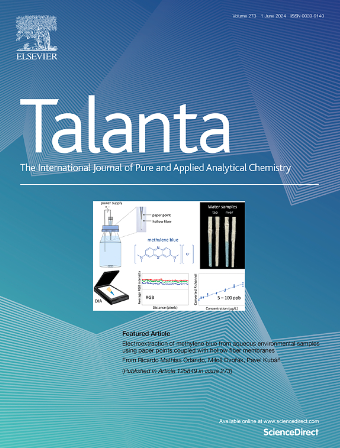Applying pulse UV irradiation-induced chemiluminescence approach for high-throughput screening assay of tyrosinase inhibitors
IF 5.6
1区 化学
Q1 CHEMISTRY, ANALYTICAL
引用次数: 0
Abstract
Tyrosinase is an enzyme that metabolizes L-tyrosine and is found in various organisms. Its overactivity can lead to health issues in humans, such as hyperpigmentation, and can adversely affect human skin, leading to skin cancers. This has heightened the significance of tyrosinase inhibitors in pharmaceuticals and cosmetics, particularly skin-whitening formulations. In this study, we developed a high-throughput screening assay for identifying tyrosinase inhibitors. This assay leverages the strong chemiluminescence signal emitted by L-tyrosine upon nanosecond UV irradiation in the presence of L-012 chemiluminescence dye, which is based on the formation of reactive oxygen species (ROS). We measured the decrease in chemiluminescence signal induced by tyrosinase enzyme, which converts chemiluminescent L-tyrosine into non-chemiluminescent L-DOPA. The addition of tyrosinase inhibitors prevents this conversion, leading to recovery in chemiluminescence of L-tyrosine. However, the reliability of the assay can be compromised by the ROS-scavenging activity and phenolic nature of certain enzyme inhibitors. To mitigate potential false results caused by some inhibitors, tyrosinase was immobilized on the microplate surface, and the inhibitors were incubated with the fixed enzyme, then, the enzyme activity was assessed after washing away the inhibitors. The proposed assay successfully facilitated high-throughput screening (less than 1 min per sample) of numerous tyrosinase inhibitor candidates from various pharmacological classes. The percentage inhibition of tyrosinase activity determined by our assay was statistically compared with results from a previously reported assay, revealing comparable outcomes and confirming the reliability of our approach. In addition, we evaluated the environmental impact and applicability of the assay using two recent metrics, yielding promising results.

应用脉冲紫外照射诱导化学发光法进行酪氨酸酶抑制剂高通量筛选试验
酪氨酸酶是一种代谢l -酪氨酸的酶,存在于各种生物体中。它的过度活动会导致人类健康问题,如色素沉着过多,并会对人类皮肤产生不利影响,导致皮肤癌。这提高了酪氨酸酶抑制剂在药品和化妆品中的重要性,特别是皮肤美白配方。在这项研究中,我们开发了一种高通量筛选方法来鉴定酪氨酸酶抑制剂。该实验利用了l -酪氨酸在L-012化学发光染料存在的纳秒紫外照射下发出的强化学发光信号,这是基于活性氧(ROS)的形成。酪氨酸酶能将化学发光的l -酪氨酸转化为非化学发光的L-DOPA,我们测量了酪氨酸酶引起的化学发光信号的减少。酪氨酸酶抑制剂的加入阻止了这种转化,导致l -酪氨酸化学发光的恢复。然而,检测的可靠性可能会受到活性氧清除活性和某些酶抑制剂的酚性的影响。为了减少某些抑制剂可能引起的错误结果,将酪氨酸酶固定在微孔板表面,将抑制剂与固定酶孵育,洗涤抑制剂后评估酶活性。所提出的分析方法成功地促进了高通量筛选(每个样品少于1分钟)来自不同药理学类别的众多酪氨酸酶抑制剂候选物。我们的实验确定的酪氨酸酶活性的抑制百分比与先前报道的实验结果进行了统计比较,揭示了可比的结果,并证实了我们方法的可靠性。此外,我们使用两个最近的指标评估了该分析的环境影响和适用性,产生了有希望的结果。
本文章由计算机程序翻译,如有差异,请以英文原文为准。
求助全文
约1分钟内获得全文
求助全文
来源期刊

Talanta
化学-分析化学
CiteScore
12.30
自引率
4.90%
发文量
861
审稿时长
29 days
期刊介绍:
Talanta provides a forum for the publication of original research papers, short communications, and critical reviews in all branches of pure and applied analytical chemistry. Papers are evaluated based on established guidelines, including the fundamental nature of the study, scientific novelty, substantial improvement or advantage over existing technology or methods, and demonstrated analytical applicability. Original research papers on fundamental studies, and on novel sensor and instrumentation developments, are encouraged. Novel or improved applications in areas such as clinical and biological chemistry, environmental analysis, geochemistry, materials science and engineering, and analytical platforms for omics development are welcome.
Analytical performance of methods should be determined, including interference and matrix effects, and methods should be validated by comparison with a standard method, or analysis of a certified reference material. Simple spiking recoveries may not be sufficient. The developed method should especially comprise information on selectivity, sensitivity, detection limits, accuracy, and reliability. However, applying official validation or robustness studies to a routine method or technique does not necessarily constitute novelty. Proper statistical treatment of the data should be provided. Relevant literature should be cited, including related publications by the authors, and authors should discuss how their proposed methodology compares with previously reported methods.
 求助内容:
求助内容: 应助结果提醒方式:
应助结果提醒方式:


